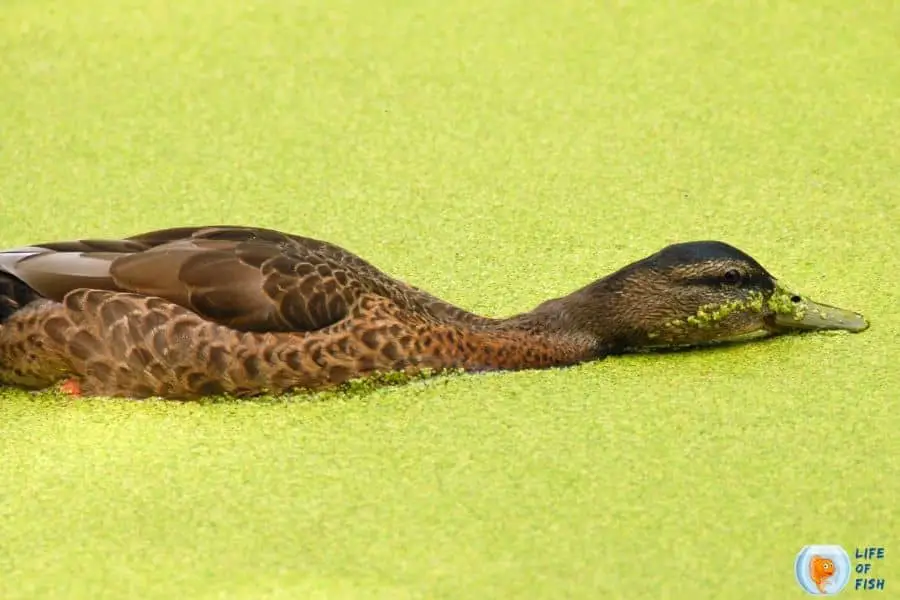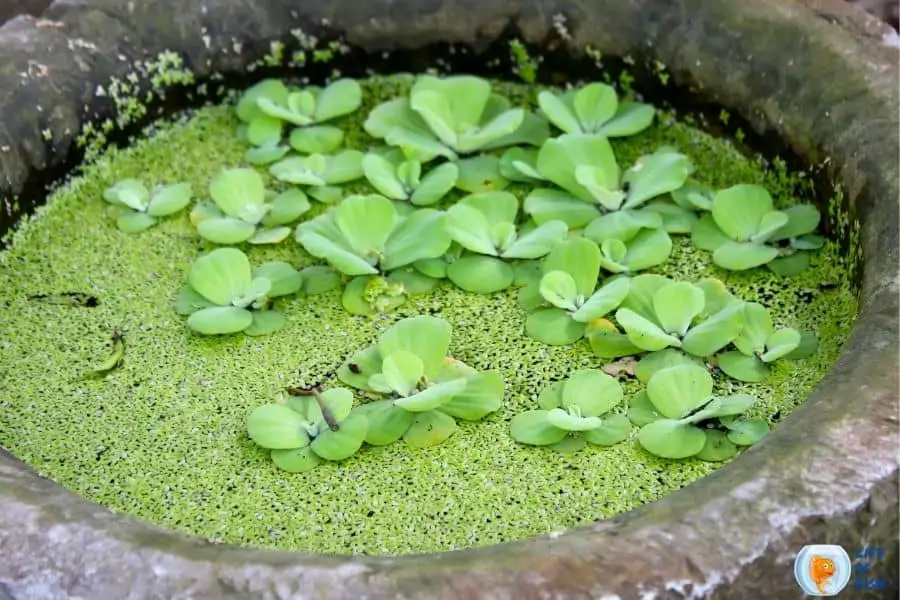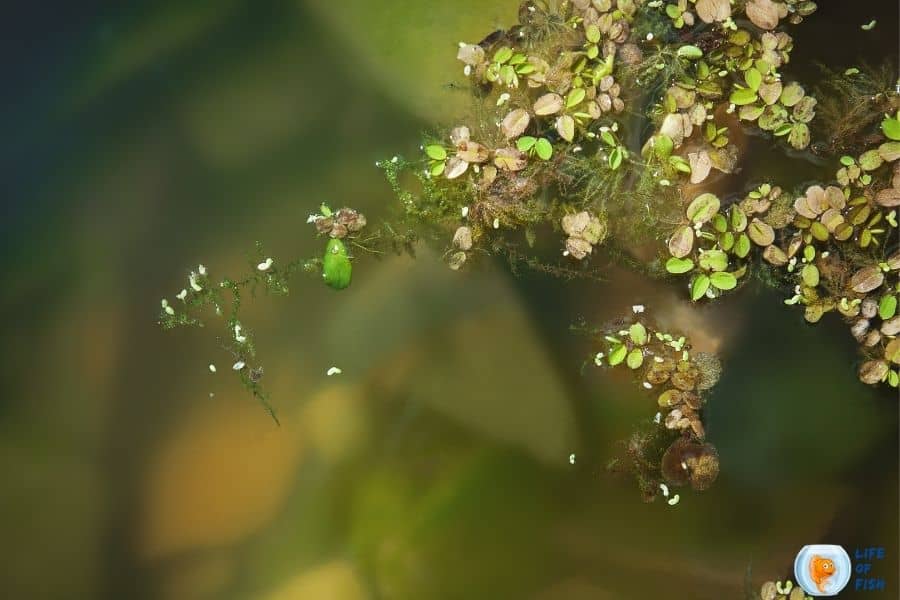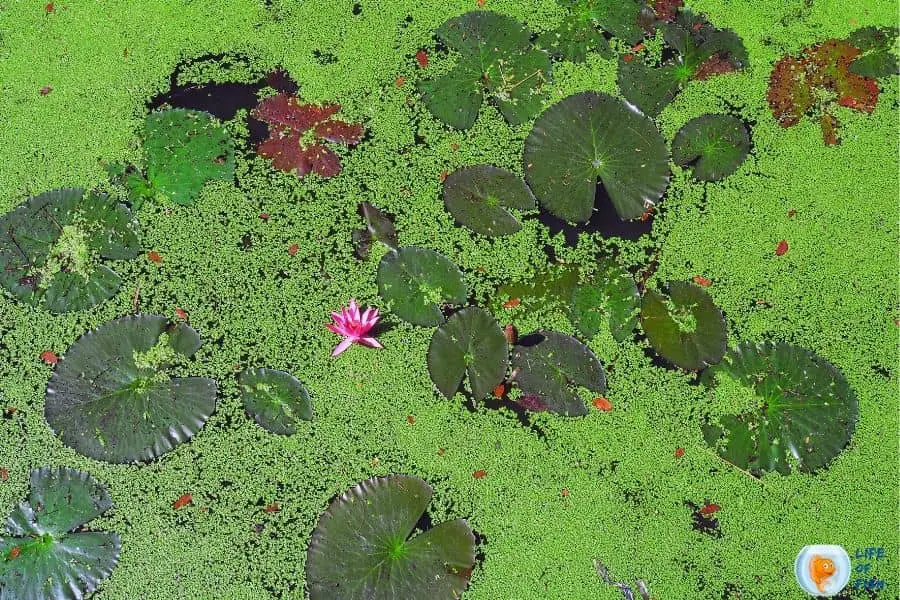Duckweeds are small free-floating plants. Usually, you can find these plants in lentic or slowly moving waters.
Duckweed is the world’s smallest angiosperms and a member of the Lemnaceae family. In this family, there are five aquatic genera. They are Landoltia, Spirodela, Lemna, Wolffian, Wolffiella, and they have close to 38 member species.
And the entire genera are reported to have phytoremediation potential leading to their large-scale utilization.
Having duckweeds in your aquarium does not harm the small aquatic life forms in the aquarium. However herbivores, fishes, and some cichlids are consuming these plants.
Since these plants are packed with nutrients and protein, You can also replace fish food with duckweed. Also duckweed is a good food source for fish such as goldfish and tilapia.

Different methods to get rid of duckweeds for a problematic situation
Jump To
Since this is a fast-growing aquatic plant. Therefore the best way to get rid of this duckweed is by removing all of the technical equipment protruding from the water surface. Also you must clean the aquarium outside.
If not, here are some different techniques for getting rid of these duckweed plants from your aquarium.
Add Natural Duckweeds Predators
Adding natural predators is one of the most effective methods when it comes to controlling the duckweed.
You must start adding these predators around and near the duckweed to eat these plants. Further, add goldfish, koi, and grass carp as they are excellent plant-eaters.
You must know that these predators may not eat the entire duckweed in your tank.
What happens here is that these fishes will ensure that small amounts of duckweed in your aquarium will not become large.
Aerate the Water
These specific plants prefer to grow in stagnant or very slow-moving waters. So to get rid of your duckweed problem, you can try to aerate the water. You can do this process by bubble aeration, which will discourage growth and kill the duckweed plants.
Rake the Water
You can physically remove duckweed plants from the bottom of your aquarium using a rake.
To do this, you must first rake the leaves together. Then start to remove the duckweed plants from the water’s surface.
After doing this, make sure that you dispose of these plants as far as possible. Ensure that no water source is nearby for them to start growing. You can use a vacuum as an alternative option to remove these duckweed plants from the surface.
Use Safe Chemicals
You can stop the duckweed from growing by using some of the safe chemicals which are available. There are various chemicals used to kill duckweeds. Some commonly used chemicals are,
- Fluridone
- diquat dibromide
- flumioxazin
Among these chemicals, diquat dibromide is a herbicide that should be used carefully as it is slightly toxic to freshwater fish.
Flumioxazin is a very fast-acting herbicide, and it is most effective when you apply it to younger plants. The most commonly used chemical in the market you can find is sonar, a chemical called fluridone.
Apply natural duckweed killer
Natural duckweed treatments are usually a mix of healthy ponds or aquarium bacteria, which will help to reduce nutrients contained in the water and starve the duckweed plants or algae.
These beneficial bacterias are not effective when it comes to removing the duckweed by themselves. Keep in mind that they will be best when used in the manual clean-out.
The good bacteria using in this treatment will help to improve the filtration and the water conditions. When the aquarium conditions are appropriate, it is challenging for duckweed to return in the future.

Use Hand Scoop Net
The hand scoop nets might not be the easiest method for removing duckweed from ponds or aquariums, especially those with fish.
You can use a solid net to get this done. Unlike algae duckweeds will always be visible on the water’s surface.
Making it easy to net out this duckweed manually. Using a hand scoop will always have better control over the tank’s cleaning process. Further if you wish to leave some behind, you can do it.
This method works best in a smaller size aquarium or pond. However if you are having a more significant size tank or a pond, it is okay as long as you constantly check your tank’s water quality.
Normally duckweed plants will not grow fast enough to require constant clean-up if the water quality is excellent in your tank.
Change Water Entirely And Clean Aquarium Equipment
Changing water and cleaning your tank equipment is a must if you are having a severe duckweed problem.
If your filter in the tank is forcing duckweed off the surface, it is best to switch off your tank filter during the cleaning procedure.
And make sure that you won’t keep the filter off for too long. Below we have pointed out how to clean your tank and eliminate the duckweed issues step by step.
- Use a net and try to collect as much as duckweed you can from the surface of the tank.
- Use a rectangular clear plastic tub, and slowly skim the surface.
- Ensure that the tank is tilt slightly and hold the tank stationary.
- Slowly draw the water into one side of the tank, this will create a vacuum effect on the side, and most of the debris on the water surface will drift down into the tank. When doing this, you will start to see the duckweed appearing from nowhere and will go into the tub
- Put the water out from the tub onto 5 gallons bucket.
- Use the tub in a different location in the tank. Make sure that you do this process few times so that the hidden duckweed on the surface is gone completely.
- Wash well the tub and hands and arms so that no hidden duckweeds will get back into the tank.
- Carefully remove algae from the subtract, plants, and the tank’s surface because sometimes there can be hidden rouge pieces of duckweed left.
- Skim any duckweed off if you still see it on the surface as before for a week.
NOTE – Monitor for few days whether new pieces of duckweed would appear or not. If so, use a net or tweezer to remove them off the tank.
Keep in mind that when introducing new plants to your existing tank. Also make sure to isolate them first in a separate bowl and see if any hidden rogue duckweed would come off them.
Always try to use other alternative methods to remove duckweed problems before resorting to chemical duckweed control. Try to remove the plants manually from the surface and reduce the nutrient levels that create bottom sediment.
Tips for Changing Fish Tank Water
Changing your fish tank’s water now and then is essential because even if your tank water looks clear, you might still have food or waste particles, hence harmful nutrients such as Ammonia and Nitrate. These tips will help you ensure a smooth water change experience and the safety of your aquarium life.
- If you have a smaller tank, perform a 10% to 15% water change weekly
- If you have a larger tank, perform a 20% water change weekly
- Do not change the water entirely unless it is required, as the change in water condition will stress out the fish
- If you use tap water, let it sit for about three days or,
- Use a de-chlorinator before adding tap water to your tank
- Test the water quality daily to ensure ideal water conditions and use mineralizers, healthy bacteria, and other medicines accordingly.
- If the water in your area is hard, use a water softener
- If you can, use RO/DI water for water changes

Methods for less problematic situations to get rid of duckweed
Bigger net for scattered duckweeds
When using your hands to scoop out the excessive duckweed plants in your tank, a commonly faced issue is that sometimes these plants may break and slip through your fingers.
Using a net through the tank is a straightforward and effective method in collecting these tiny bits of duckweed that might escape when trying to remove this from hand.
It would help if you always skimmed the net through your aquarium at least a few times until the entire duckweed in your tank is gone.
By chance, if you have a large aquarium, then using a net might not be the best solution. In these cases, you can use a skimmer which is very effective when removing duckweed in ponds and large aquariums.
You must never forget that doing this process is not essential to do if your goal is only to control the growth of your tank’s duckweed and intend to keep some to benefit your fish.
Introduce duckweeds eating fish
Another effective technique for removing the duckweeds from your pond or aquarium is adding some natural predators such as goldfish, koi, grass carp that eat these plants.
This technique prevents the growth in large aquariums and ponds or keeps the growth problem under control.
Reduce fish food
If you have any natural predators for duckweed, such as goldfish, koi, or grass carp, you can try reducing the amount of fish food you are supplying them.
Doing so will encourage them to eat duckweed. Goldfish love to eat duckweed more than koi fish. But they will not ignore the easy meal you provide if you have a hungry carp fish.
Many fish ponds or aquariums will not face this issue with duckweed overgrowing because the fish will eat it faster than the weeds grow back.
But like we mentioned, if you feed your fish frequently, they might be too full to eat the duckweed.
If your tank has a duckweed issue, you can try reducing feeding to every other day to increase the number of weeds eaten by the fish.
Remember that when you resume feeding your fish with fish food again, make sure that you use a very high-quality fish food as possible to help reduce fish waste.
Higher quality fish food will have lower filler content (ash) and higher contents of ( protein, fats, minerals, etc.) that your fish need to live.
Regular monitoring
If these duckweed plants are kept unchecked, you might have indirect issues in the future. Therefore, you should monitor the tank regularly to ensure controlled duckweed growth.
A small number of duckweeds are actually beneficial for your fish. But, if the duckweeds overgrow, that is because it receives enough nutrients from the environment.
So, you should check water conditions daily and take the necessary steps to control duckweed growth in your aquarium.

Importance of duckweeds in the aquarium
Small numbers of duckweed might be beneficial as it can help reduce excess nutrients, control algae growth, improve oxygen levels and sometimes even provide shade and protection from predators.
Further, duckweeds are an excellent source of food for herbivore fish in your aquarium. The issue with these plants is that if your pond or aquarium is already high in nutrients or has problems with water quality, it can grow very fast.
Disadvantages of duckweeds
Duckweed plants will cause issues with your water quality. Mainly in ponds and aquariums with fish, since the excess duckweed can reduce oxygen levels and cause harmful spikes in ammonia.
When duckweed grows, a similar amount will die off, and as good bacteria work to break down the decomposing matter, they consume large amounts of oxygen from the water.
If the amounts of decaying matter become too high for biological filtration, ammonia and nitrite levels will rise, and oxygen levels will reduce from the aquarium until the waste is decreased entirely from the tank or pond.

Related questions
Can duckweeds kill fish?
No. duckweed is not toxic to animals or wildlife.
How do you get rid of duckweed naturally?
You can add natural predators such as goldfish, koi, or grass carps since these fishes will consume the duckweed and prevent it from spreading.
Does duckweed clean water?
Yes, duckweed loves muck. It can clean the water.
Conclusion
If you do not have any fish in your pond or aquarium, keeping these plants is more personal, as it will not cause any significant issues with the ecosystem.
But if you have other plants alongside duckweed, such as water lilies, these can begin to suffer when the duckweed plants rise to compete with the nutrients.
Duckweed plants are commonly known for taking nutrients and stabilizing aquariums or ponds with algae problems.
However, many aquarists consider this plant a pest because it is a fast-growing plant. Fortunately, getting rid of duckweed is easy.
Following the above methods, you can get rid of duckweed in aquariums easily.
Read Next: 3 Super Easy Ways To Get Rid Of Tannins In Fish Tank
